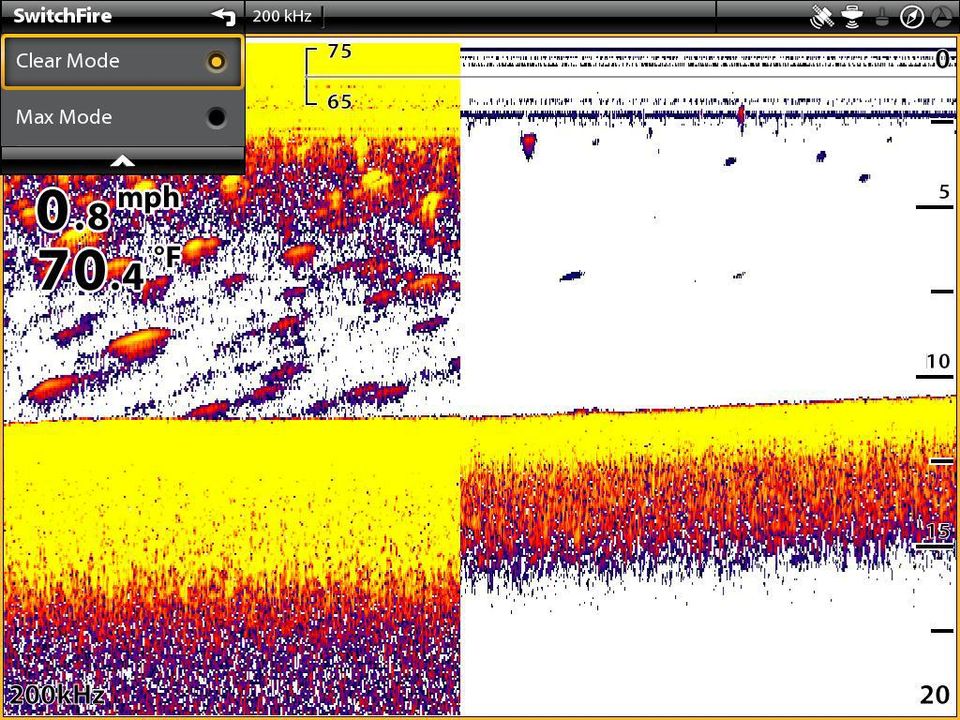What exactly is Humminbird SwitchFire?
Every current Humminbird fish finder includes, as part of its traditional 2D sonar toolbox, Switchfire, which has two fundamental settings: Max and Clear. But what is Switchfire, how does it work, and which setting is right for you? Read on!
Switchfire is Humminbird's implementation of "Time Variable Gain", or TVG. Time variable gain is a software process by which the gain (think, sensitivity) applied to a sonar return changes as a function of that sonar return's depth. With TVG, the gain applied to a sonar return that is close to the surface is low, and the gain applied to a sonar return deeper in the water column is higher. TVG is most useful for determining the relative size of fish returns in 2D sonar at depths throughout the water column; a 3" bluegill will provide a weak sonar signal at 3' and at 20', while a 6 lb walleye will provide a strong sonar return in both the shallows and out deep.
Now, how is this connected to Switchfire? Simply put, Switchfire MAX has TVG turned OFF, while Switchfire CLEAR has TVG turned ON.
How do these two Switchfire settings impact your 2D sonar views? With Switchfire MAX (TVG off), your 2D sonar views will often be full of fish returns, but it is important to realize that many of these may arise from very small fish (especially high in the water column). With Switchfire CLEAR (TVG on), your 2D sonar views will have fewer returns, and the strengths of the sonar returns you see from fish will be more representative of their actual sizes. An example is below, showing Switchfire CLEAR on the right and MAX on the left.
Switchfire is Humminbird's implementation of "Time Variable Gain", or TVG. Time variable gain is a software process by which the gain (think, sensitivity) applied to a sonar return changes as a function of that sonar return's depth. With TVG, the gain applied to a sonar return that is close to the surface is low, and the gain applied to a sonar return deeper in the water column is higher. TVG is most useful for determining the relative size of fish returns in 2D sonar at depths throughout the water column; a 3" bluegill will provide a weak sonar signal at 3' and at 20', while a 6 lb walleye will provide a strong sonar return in both the shallows and out deep.
Now, how is this connected to Switchfire? Simply put, Switchfire MAX has TVG turned OFF, while Switchfire CLEAR has TVG turned ON.
How do these two Switchfire settings impact your 2D sonar views? With Switchfire MAX (TVG off), your 2D sonar views will often be full of fish returns, but it is important to realize that many of these may arise from very small fish (especially high in the water column). With Switchfire CLEAR (TVG on), your 2D sonar views will have fewer returns, and the strengths of the sonar returns you see from fish will be more representative of their actual sizes. An example is below, showing Switchfire CLEAR on the right and MAX on the left.

Notice how the Switchfire MAX view on the left appears to be full of fish, while those same fish are absent in the Switchfire CLEAR view. This is because, in shallow water, even a small fish will produce a sizable sonar return when time variable gain is turned off. When time variable gain is turned on (Switchfire CLEAR), the sonar returns from those small fish will become far less apparent at low 2D sonar sensitivity and surface clutter.
Which Switchfire setting is right for you? When relying on 2D sonar to find catchable-size fish, I use Switchfire CLEAR. When searching for bait schools, or trying to identify fish when running at high speed, I will use Switchfire MAX. Check out our quick reference cards for core, HELIX, and ONIX models to see more examples of times that we rely on Switchfire MAX and CLEAR, and the ways that we use Switchfire in conjunction with 2D sensitivity and surface clutter to optimize our 2S sonar views.
Which Switchfire setting is right for you? When relying on 2D sonar to find catchable-size fish, I use Switchfire CLEAR. When searching for bait schools, or trying to identify fish when running at high speed, I will use Switchfire MAX. Check out our quick reference cards for core, HELIX, and ONIX models to see more examples of times that we rely on Switchfire MAX and CLEAR, and the ways that we use Switchfire in conjunction with 2D sensitivity and surface clutter to optimize our 2S sonar views.